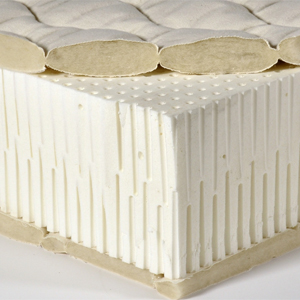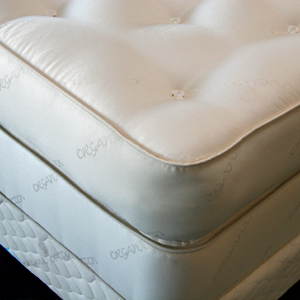Mattress shopping can be one of the most agonizing experiences, from pushy salespeople to an overwhelming number of options to not actually knowing what you need in the first place. It’s so easy to end up with the wrong one, but it doesn’t have to be that way.
The Huffington Post spoke with Jay Orders, the co-owner of Christeli, to get a better understanding of what we really need to look for when we hit that showroom floor. His family has been in the mattress-manufacturing business since 1931, and he’s worked in almost every part of that process in a factory setting to be able to separate the hard product truths from the marketing myths.
“People come in with a list of specifications, because there’s so many things out there about mattresses that they read,” Orders told The Huffington Post. “A good mattress is something most people don’t know a lot about: How it feels, the quality of the construction, the quality of the materials used, the final product. There’s a lot of information out there, and it’s hard to trust some of it. There’s a lot of smoke and mirrors.”
Ready to look past all the gimmicks? Here are seven myths you’ve probably heard at some point in your mattress shopping endeavors that couldn’t be further from the truth.
Myth #1: You must, must, MUST get a pillow-top mattress because they make the most comfy beds EVER.
“I always get requests for things that don’t make sense,” said Orders. “For instance, people always ask for a pillow-top mattress, and when I ask why, they say they heard it’s supposed to be a softer, nicer mattress, but none of that’s true. I have to explain to them it’s just a marketing gimmick.”
This is a common misconception created by different companies looking to distinguish their products from their competitors. But Orders claims that the same plush feel can be achieved with a traditional mattress design, despite how boring that may sound. It’s more so about the structural integrity of the mattress. And if you want to create a fluffy princess bed, there’s nothing wrong with topping off a solid, standard mattress with a cushioned pad of your choice.
Myth #2: No biggie — one size fits all.
Try again. Why would one mattress feel the same, offer identical support and last the same amount of time for a 120-pound woman and a 250-pound man? Simple answer: It wouldn’t.
It seems to be a growing trend among new mattress companies to try and cut out the complicated distinctions that come along with a catalog of different models, and make the case that all mattresses are essentially the same. But it’s still important to factor in things such as a person’s natural sleeping position, any sleeping difficulties or disorders, their age and weight, and general preferences from previous mattress experiences, according to Orders.
Myth #3: You’re most definitely going to get the total value (and then some) of that lifetime warranty.
“When most companies say ‘lifetime warranty,’ they’re referring to the materials inside the mattress, which really isn’t a warranty at all,” said Orders. “It’s saying as soon as this mattress is worn out from normal wear and tear, it’s no longer covered under warranty. It’s very vague and can get very expensive.”
The National Sleep Foundation recommends changing your mattress every seven to 10 years, regardless of any outstanding warranty. That’s the most important detail to keep in mind. How long your mattress will last depends on several factors like usage and its original quality, but generally speaking, it’s gotta go after that 10 year mark. It won’t provide you much support and comfort after that.
Myth #4: There’s no such thing as a proper bed setup without a box spring…

Unless your bed frame still uses slats for support, you do not need a box spring, according to Orders. Box springs were first invented to help absorb shock since mattresses themselves were so much thinner back then. Nowadays, all box springs really do is just raise the profile of your bed. So again, if you’re going for the princess look, start stacking. Otherwise, it’s just an additional, unnecessary cost. All you need is a solid platform underneath your mattress for support.
Myth #5: Giving your mattress a test lie-down on the showroom floor is enough.
Believe it or not, the only real way to test out a mattress and make sure it’s the one for you is to actually sleep on it. (Mind blown, right?)
This fact is key when it comes to shopping with a mattress company that offers both a reasonable trial period and return shipping rates in case the one you choose initially ends up not being the perfect fit. Some companies don’t offer trials at all, and others’ return pricing can get pretty steep. Either way, don’t just sneak in a catnap in the store and call it a day here.
Myth #6: There’s a reason these people are selling mattresses: They’re SLEEP GENIUSES.
Sorry folks, it doesn’t take much sleep expertise to work as a mattress salesperson. And just like many others in the trade, they work on commission, says Orders, which is why in many retailers, they tend to push the higher priced options the hardest.
When it comes to gaining the best mattress insight, Orders recommends finding someone you really trust and discussing your needs and concerns candidly with them. Product reviews online can also be a great source of information that are worth a read. Keep your eye out less for brand names and more for quality materials, because that’s what’s ultimately going to help you sleep well at night.
Myth #7: If you have a bad back, you’ll regret not buying a hard, firm mattress.
“We get this one a lot,” said Orders. “People think that it’s going to provide the best support, which isn’t necessarily true. Your spine has a natural curvature, so the optimal sleeping position is to have your spine as close to that natural curvature as possible, because it creates the least amount of pressure.”

Sleeping on a mattress that is too firm creates aches and pains on pressure points rather than catering to that curvature, leading to a night full of tossing and turning. It’s important to pick one that supports your head, shoulders, hips and feet all in proper alignment. Those who struggle with back issues need to pay particular attention when shopping to find the fit that’s both supportive and comforting in all the right places.
By Alena Hall for the Huffington Post.











#5 above talks about how the only real way to test out a mattress and make sure it’s the one for you is to actually sleep on it–not just test it out in the showroom. But your company does not offer trials or returns, so how can I really test out the mattress I think I want to buy from you? Please let me know what options I have other than “blindly” buying a mattress from good night naturals.
Hi. Thanks for your great question. We do have a comfort exchange program. If the mattress you choose is not right, we work with you to find one that will work. Also, we offer free consultations via phone which will allow you to discover which mattress is perfect for your specific needs. Call us at 866 388 5154 Paul